Check out my custom vibration dampener
Types of Tennis Strings
A comprehensive guide
We hope you love this article. Just so you know, TennisCompanion may collect a small share of sales from the links on this page to help keep this site running. Learn more.
If you’re in the market for a new set of tennis strings or buying your first set, it pays to be familiar with the different types of tennis strings.
By understanding which strings are available and the common attributes associated with each, you’ll be able to narrow your options and confidently select a string that meets your needs. Furthermore, the right string can improve your performance, help you avoid or improve nagging arm injuries like tennis elbow, and save you money.
In this guide, we’ll provide you with an overview of the different types of strings available, including common materials and construction. We’ll also discuss the pros and cons of each and review the topics of string gauge and tension to help you learn which string type is the best for you.
Article Contents
Click below to jump to a section
Tap below to jump to a section
Types of Strings Video
Two Categories of String
Natural Gut
Synthetic
Synthetic Gut
Multifilament
Polyester
Kevlar
String Construction
Hybrid Strings
String Gauge
String Tension
Finding the Right String
Restringing
Wrapping Up
New to TennisCompanion?
Create a free account and explore my latest videos below
Types of Tennis String Video
For a visual walkthrough of the different types of tennis strings, be sure to check out my video below.
Here are timestamps within the video if you’d like to jump to a specific section:
0:21 – Why Strings Are Important
1:01 – String Families
1:44 – Natural Gut
2:40 – Synthetic Gut
3:25 – Multifilament
4:02 – Polyester
4:47 – Kevlar
5:22 – Hybrid Stringing
5:44 – Wrapping Up
You’ll find extra detail that pairs well with the above video in the sections of this guide that follow.
The Two Categories of Tennis String
We can categorize all tennis strings in one of the two following buckets:
- Natural gut
- Synthetic
Back in 1875, Babolat introduced the first natural gut strings, and for decades they reigned supreme as the only string available.
However, in the 1950s, the first synthetic strings were developed and today represent the largest share of strings on the market.
In the following sections, we’ll review these categories in-depth. Keep in mind that as we discuss the advantages and disadvantages of each string that we’re speaking in generalities.
As with most things, there are exceptions to the rules. Moreover, the qualities of tennis string, such as feel, are subjective, so we’ve done our best to provide an accurate representation of what you can expect from each category.
Natural Gut Strings
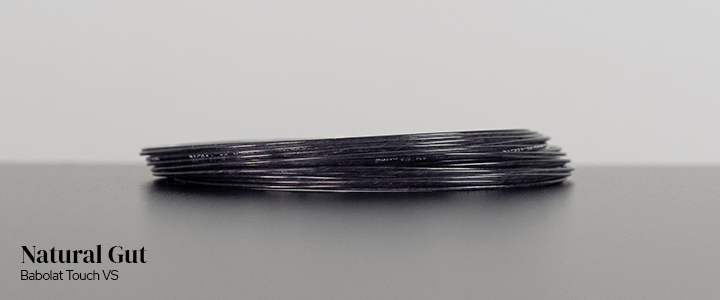
To the surprise of many, manufacturers create natural gut strings from a complex process that transforms cow intestine into tennis strings.
At first, this may sound like a shocking material to use in the creation of tennis strings. However, if you consider the fact that they were introduced in the 1800s before modern textiles existed, then it starts to sound a bit more reasonable.
Despite the unusual material, natural gut is widely considered some of the best tennis string on the market and a popular choice among professional players, like Roger Federer.
Due to their highly elastic properties, natural gut strings offer superior power, feel, and comfort. Beyond that, this category of tennis string does a great job of maintaining tension longer, which to date has been difficult to match even with advanced synthetic materials.
However, compared to some synthetic strings available, they’re not nearly as durable, they’re susceptible to moisture, and by far the most expensive due to the complex manufacturing cost.
As a result, you won’t typically find many club or recreational players using natural gut strings. Instead, they’re more frequently used by advanced players who demand the best and can afford the cost of maintaining them.
Luckily, there are a wide variety of less expensive synthetic gut strings on the market that offer similar characteristics.
Natural Gut Advantages
- Power
- Comfort
- Feel
- Tension stability
Natural Gut Disadvantages
- Price
- Spin
- Durability
Natural Gut Advice
If you can afford them, natural gut tennis strings are a fantastic option for a wide range of players, but for most, they’re overkill.
As a beginner, it may be tempting to purchase the best or most expensive gear to improve your performance. However, when first starting, you’ll be hard-pressed to notice the difference between natural gut and an inexpensive synthetic alternative, as string performance is relatively nuanced. Instead, developing sound technique and practice will primarily influence your results.
Similarly, if you play casually or infrequently, then natural gut most likely won’t be worth the expense, but it won’t hurt either.
On the other hand, if you’re a highly competitive player working intensely on all aspects of your game and looking to find the edge anywhere you can, then natural gut tennis strings might be an excellent fit. With a high level of skill and experience, you’re likely to recognize and appreciate the added feel of these types of strings, as long as you can afford to maintain them.
Natural Gut Picks
If you’re looking to give natural gut a try to enhance your performance or perhaps because you want to experience what the strings have to offer, then we’d recommend the following for you to try.
| Babolat VS Touch |
| Wilson Natural Gut |
| Luxilon Natural Gut |
Synthetic Tennis Strings
Natural gut strings can be a fantastic option for some players, but most will find the variety and price of synthetic strings more appealing.
As the name implies, this type of tennis string uses various synthetic materials to provide players with a wider range of options.
When creating these strings, manufacturers control the material as well as the construction or makeup of the strings. The result is the ability to design strings that enhance virtually any feature, such as comfort, durability, spin, and power.
Within the synthetic family, there are three primary materials in use to create tennis strings:
- Nylon
- Polyester
- Kevlar
We’ll start by reviewing each of these materials, and then we’ll walk through the different construction in use across them.
Nylon
Without a doubt, the most popular member of the synthetic string family is nylon. You’re likely familiar with nylon from its use in clothing. However, it’s a diverse material that comes in various grades and is in use across a wide range of commercial products.
Synthetic gut and multifilament strings are both typically made with nylon, but the quality of nylon and construction are what differentiate one type of string from another.
Synthetic Gut
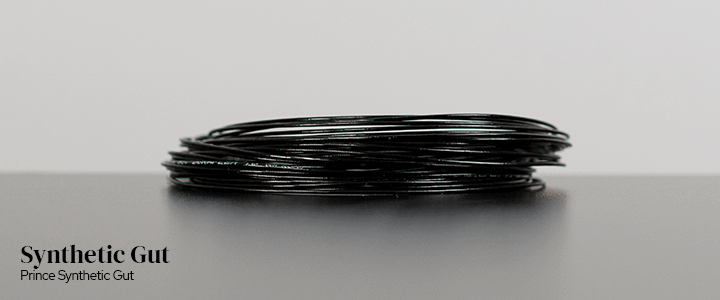
Don’t let the name fool you. Strings labeled as synthetic gut are low-end tennis strings that provide moderate all-around performance at a great price. For most casual or recreational players, synthetic gut is the string of choice purely based on cost.
Within the realm of synthetic gut, there’s substantial variety. For the most part, you’ll find these strings feature a solid core construction with one or many outer wraps. Typically, the more outer wraps, the higher the durability and cushion or comfort provided by the string.
We’ll cover this with some visuals in the construction section of this guide, but it’s worth noting here to help understand where much of the price variance comes into play with synthetic gut strings.
Synthetic Gut Advantages
- Price
- Moderate all-around performance
Synthetic Gut Disadvantages
- Durability
- Spin
- Feel
Synthetic Gut Advice
If you’re new to tennis or you play casually and infrequently, then synthetic gut tennis strings are a great option. They’re also ideal for players or parents who are on a budget.
If you’re an intermediate player who has been using inexpensive synthetic gut strings as you’ve been learning the game, then they’ll still serve you well. However, you’re likely approaching the stage where your skill-level will allow you to reap the benefits of the specialized strings we’ll cover in the rest of the guide, and we’d encourage you to begin experimenting with them.
Synthetic Gut Picks
Here’s a selection of our favorite synthetic gut tennis strings.
| Gamma TNT2 |
| Prince Synthetic Gut with Duraflex |
| Goosen OG Sheep Gutt |
Multifilament
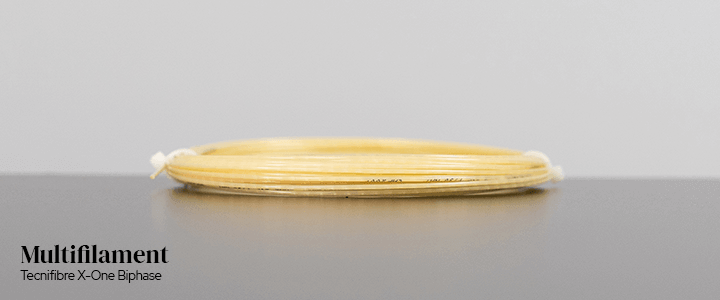
In many ways, multifilament tennis strings are the big brother to synthetic gut. These strings were born out of the desire to make a better synthetic tennis string that had more of the qualities of natural gut, but with fewer of the drawbacks, i.e., increased durability.
As technology and materials evolved, manufacturers were able to build better synthetic strings by using a new construction method that weaves together thousands of fibers to mimick natural gut. The result is a popular string that offers terrific power, comfort, and greater durability due to the synthetic materials put to use.
As with synthetic gut, there are varying degrees of quality in both material and construction used for multifilament tennis strings, which is why you’ll see much of the price variance from string to string.
Helpful Tip
An area that draws confusion for new players to the game is that multifilament refers to both a type of string and, as you’ll learn later in this guide, a type of construction. I’ve found sharing this seemingly insignificant detail helps clear things up.
Multifilament Advantages
- Power
- Comfort
- Feel
- Durability
Multifilament Disadvantages
- Spin
- Control
Multifilament Advice
As a beginner, multifilament tennis strings are a great option. However, with one exception, my advice is the same as I gave for natural gut, in that it’s most likely not worth spending the extra money when you won’t be able to notice the difference from one string to another.
The one exception would be for adults who are picking up the game later in life and have struggled with any sort of arm injury. Due to their makeup, multifilament strings are high on comfort, so even if you can’t tell the difference between these strings and synthetic gut, your arm will thank you.
Where multifilaments shine is as a step-up for intermediate players that are currently using synthetic gut and looking for more performance out of their tennis strings.
Multifilament Picks
These days, you’ll find more options for multifilament tennis strings than you will for synthetic gut, so it can be tricky to identify quality strings that you can trust. Here are a few of our favorites.
| Wilson NXT |
| Tecnifibire X-One Biphase |
| Babolat Xcel |
Polyester
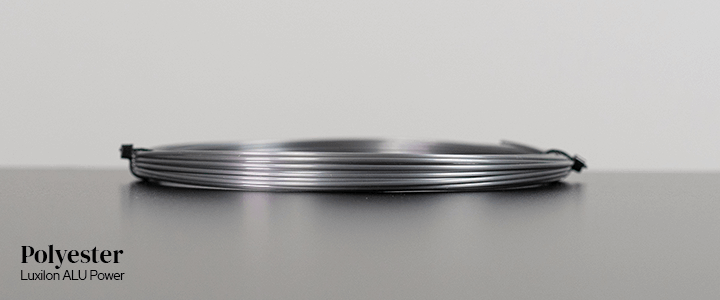
Polyester tennis strings were introduced around 1997 when Brazilian Gustavo Kuerten strung his racquet with the first polyester from Luxilon. The strings allowed him to hit harder and with more topspin, and he battled through the field to win the French Open that year.
Fast forward a few decades, and tennis has evolved substantially. Players are stronger, and they’re using more extreme grips that allow them to swing harder to generate topspin without sacrificing control. Tennis strings are part of the equation that makes that possible.
Polyester strings are low powered and durable, which allows players to take huge cuts at the ball to generate high levels of topspin without sacrificing control or breaking the strings. They also exhibit a unique snapback effect that studies have shown to enhance topspin.
Due to their stiff, more durable construction, polyester can be hard on a player’s arm, so they’re frequently combined with natural gut or multifilament strings to provide players with durability while maintaining a more forgiving, natural feel.
These days, they’re one of the most popular strings due in large part to professionals like Rafael Nadal, who strings with a full bed of polyester to generate massive amounts of topspin, but they’re not for everyone.
Helpful Tip
Many polyester tennis strings feature additives to alter the properties and playing characteristics of the string. You’ll typically see these strings marketed as co-polys.
Polyester Advantages
- Spin
- Control
- Durability
Polyester Disadvantages
- Comfort
- Feel
- Tension stability
Polyester Advice
To truly reap the benefits of polyester tennis strings, players must possess proper technique and a high level of skill.
One of the main factors that dictate topspin is the speed at which a player swings their racquet. Assuming the right grip is in use, a faster swing will result in more topspin.
When players are starting, they won’t possess the skill to swing a racquet with enough speed and accuracy, and therefore in most cases, the low power of polyester won’t be of any benefit. Furthermore, while polyester string to exhibit a snapback effect, this won’t happen unless a player strikes the ball hard enough to deform the strings.
With that in mind, we’d recommend against polyester for beginners and early intermediate players who wouldn’t benefit from the advantages the strings have to offer but would also have to deal with the disadvantages of low comfort and feel. If you suffer from arm injuries or discomfort, we’d also recommend you steer clear.
Players that will benefit are intermediate to advanced who have developed the technique and racquet head speed necessary. If polyester strings are of interest, you may want to consider this string as part of a hybrid setup – more on this to follow.
Polyester Picks
Here are a few of our favorites from three different tennis brands:
| Luxilon ALU Power |
| Babolat RPM Blast |
| Wilson Revolve |
Kevlar
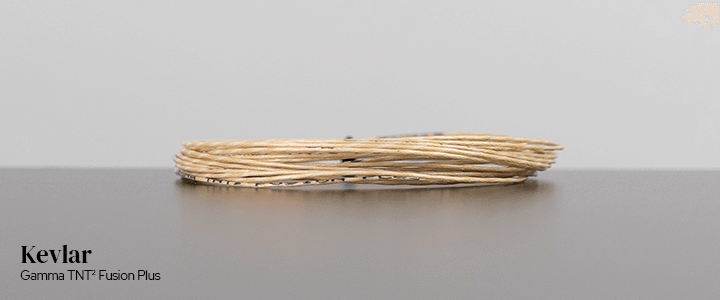
Kevlar or aramid fiber strings provide players with maximum strength and durability, but they are subsequently the harshest strings on the market. This type of string is most frequently used by chronic string breakers in combination with nylon strings to reduce the harsh feel.
While still in use, these strings have been primarily replaced by polyester strings, which have only become more and more popular.
Kevlar Advantages
- Durability
- Control
- Tension stability
Kevlar Disadvantages
- Comfort
- Feel
- Spin
Kevlar Advice
Most players will steer clear of Kevlar due to their harsh feel, but chronic string breakers are a niche that appreciates them.
Not only are Kevlar strings incredibly durable, but they do one-up polyester tennis strings in one area, which is tension stability, or their capacity to maintain a specific tension longer.
If you are a chronic string breaker, you know how expensive stringing can be. Growing up, I fell squarely into this camp.
One option would be to use polyester tennis strings, but if you’re looking to save money by avoiding breaking strings, then this might not be the best route. That’s because a drawback to polyester strings is that they tend to lose their tension quicker and go “dead,” which means they’re relatively high maintenance and need to be restrung more frequently.
If you’re a chronic string breaker with a healthy arm that needs each string job to last, then Kevlar can be a great option when strung as a hybrid. You’ll want to use Kevlar in the mains.
Kevlar Picks
| Prince Pro Blend |
| Crossfire Plus |
| Crossfire ZX |
Synthetic String Construction
Now that we’ve covered the three main types of string materials, let’s dive into the most common string construction.
Solid Core & Outer Wrap(s)
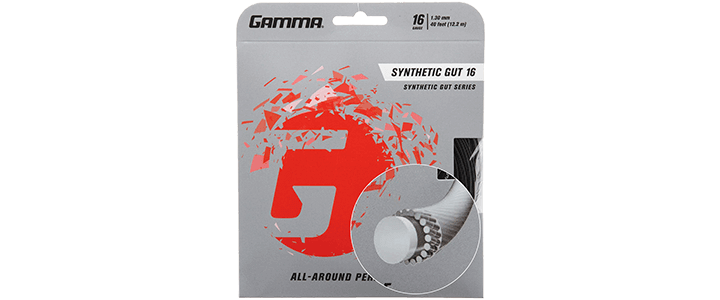
A traditional string construction used heavily with synthetic gut strings is a solid core with a single layer of outer wraps.
Often, players describe these strings as having a crisp feel, especially when compared with multifilament (more on these to follow) or natural gut strings. In most cases, the quality of this type of string is a direct result of the grade of material used, which most frequently is nylon, such is the case with Gamma Synthetic Gut pictured above.
Although not as typical, solid core strings with multiple outer wraps provide many of the same characteristics with the added benefit of increased durability and a slightly softer or cushioned feel.
Monofilament

Monofilament, which consists of a single solid filament, is the most basic construction of the bunch. Typically, manufacturers make monofilament strings with polyester. The single larger filament combined with the stiff properties of polyester makes them some of the most durable strings on the market.
The vast majority of monofilament strings are low powered and provide a level of control well beyond what other stings offer. Pictured above, Babolat RPM Blast is an example of a monofilament polyester string.
Due to their stiffer feel, you’ll often find players combining monofilaments with natural gut, a multifilament, or synthetic gut.
If you’re a player suffering from an arm injury, you’re most likely not going to find the comfort you’re looking for in a monofilament.
Multifilament

Multifilament tennis strings have become popular over the years and are considered by some to be the top category of string construction after natural gut.
Multifilament strings are created through a process similar to natural gut – by weaving hundreds or thousands of microfibers together, as you’ll find with Dunlop’s Silk Pro tennis strings.
The result is a string that provides a soft, almost cushion-like feel. As a result, these strings have become an excellent option for players suffering from arm injuries.
Some players might be surprised or slightly turned off by the fraying that occurs with multifilament strings as they wear down, which is a result of the breakage of tiny fibers used to create these strings.
Due to their added durability, multifilament strings are also frequently found as part of hybrid strings sets, such as Wilson’s NXT Duo II.
Textured
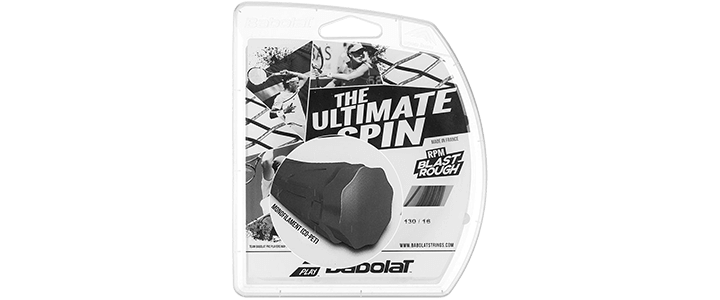
More recently, companies like Babolat have experimented with the shape and texture of monofilament strings, and such is the case with RPM Blast Rough shown above.
Textured strings may also be constructed through the addition of an outer wrap or by incorporating a larger wrap within the outer layer, which creates a raised band and gives texture to the strings.
In some cases, manufacturers flip this approach by adding grooves to strings, which produces a similar effect.
Composites

Composite tennis strings are a result of combining multiple types of materials or grades of materials in an attempt to create a string that shares the benefits of each.
With that said, composites are less a construction and more a method of combining materials to achieve certain playing charatersitcs, but we’ve included them in this section for simplicity.
As such, the construction varies among these strings. Wilson NXT Control is an example of a composite multifilament that features polyester and nylon in its creation.
Hybrid Strings
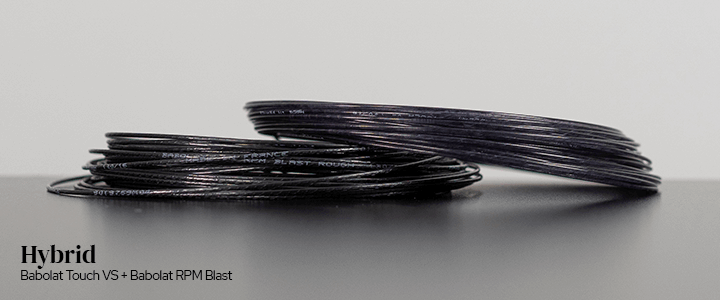
Hybrid stringing combines the benefits of two different types of tennis strings by using them both within a racquet – one set for the mains and another for the crosses.
As an example, a chronic string breaker might use durable strings as the mains (the strings that run from the bottom of the racquet head to the top) and then incorporate a softer, more playable string as the crosses, which experience significantly less friction and movement.
The result is a combination that seeks to find a balance between a comfortable feel and control while providing players with the durability that would be hard to come by through the use of a softer string type throughout the entire racquet.
One of the most popular examples of this type of string is the Wilson Ultimate Duo II Hybrid strings. It’s also common to combine natural gut strings with synthetic as a more affordable and durable option, such as Wilson’s Champions Choice Hybrid does.
Helpful Tip
When using a hybrid setup, keep in mind that the string in the mains will tend to dominate the overall feel of your racquet.
Tennis String Gauge or Thickness
Now that you have a good understanding of the materials and construction used to build tennis strings, there is one last variable worth considering when buying or testing a new set of strings.
In most cases, different styles of tennis string will come in various gauges or thicknesses, providing players with even more options.
Below you’ll find a list of currently available string gauges.
| Gauge | Min (mm) | Max (mm) |
| 19 | 1.00 | 1.10 |
| 18 | 1.10 | 1.16 |
| 17L | 1.16 | 1.20 |
| 17 | 1.20 | 1.24 |
| 16L | 1.22 | 1.26 |
| 16 | 1.26 | 1.33 |
| 15L | 1.34 | 1.40 |
| 15 | 1.41 | 1.49 |
For most players, the main benefit of a thinner string such as 18 would be to increase the potential for spin on their shots.
It’s important to note the distinction between the potential for spin and the ability to produce more spin. For example, if you hit flat with little spin, then you may not notice much of a difference with thinner strings.
On the other hand, if you hit with a ton of topspin and move from a 15 gauge string to 18, there’s a high likelihood you’ll notice that you have the ability to generate additional spin. The spin results because the strings embed more easily and, therefore, “grab” the ball, helping produce more spin.
Beyond the increased potential for spin, players will often go with a thicker string, such as a 15L gauge string for added durability. Hard hitters and chronic string breakers will often opt for a higher string gauge to help prolong the life of their strings.
String Tension
Similar to string gauge, the tension at which you string your racquet has an impact on each type of string. However, regardless of which type of string your using the same general truth will apply.
When stringing your racquet, you’ll first want to refer to the recommended tension ranges printed on your racquet, as this will provide you with a good starting point. If you’re not sure where to start, use the halfway point of the recommended tension.
From there, you can experiment with dropping your tension for more power or increasing your tension for more control.
If you’re looking for more spin or durability, you’d also want to look at dropping the tension. As you might imagine, this is a rather involved topic, which you can learn more about in our string tension guide.
Finding the Right String
As with selecting a tennis racquet, there isn’t a one-size-fits-all approach to tennis strings. However, here are some things to consider to help you find and choose a great set of strings.
Your Level of Play
If you’re just getting started with tennis, then it probably won’t make sense to spring for an expensive set of tennis strings. When you’re just starting, it can be tough to recognize the benefits that a more expensive set of strings like natural gut provides.
As a result, synthetic gut strings with a solid core and single or multiple wraps are a great option, since you’re likely to find a great string that’s durable at a price that makes sense.
Frequency of Play
The more you play, the more quickly your strings will lose their tension or break. If you’re competing at a high level, you may be able to justify the higher cost associated with a more expensive set of high-quality strings. However, most recreational players who step out on the court frequently may opt for a more durable set of strings that will hold up and provide great feel and playability without breaking the bank.
Multifilament and hybrid strings can be a great option for people who hit the court frequently.
Arm Injuries
If you’re experiencing discomfort or arm injuries, such as tennis elbow, then the best set of strings will be natural gut, multifilament, or if it’s not a major issue, a hybrid that incorporates a softer string.
These string setups will help reduce the stress on your arm while still providing you with a string that is durable and plays great.
Style of Play & Personal Preference
It can also be highly beneficial when selecting a tennis string to consider your style of play.
For example, if you spend most of your time on the baseline hitting big groundstrokes with a ton of topspin, then you may want to consider a low gauge polyester string for increased spin potential.
An all-court player may want to go with a hybrid setup that offers them a blend of spin for their groundstrokes without sacrificing the feel they enjoy up at the net.
Ultimately, there is no right or wrong answer to which types of strings you should use. However, by spending the extra time to ensure your strings complement your style of play and meet your personal preferences, you can gain an edge over players who overlook them.
Experiment
Nothing beats trying a string for yourself to develop your own opinions on how a string performs and feels. As such, we’d recommend that you use this guide to narrow down your options and then pick a few that you’d like to give a try.
If you have multiple racquets, you can try a different string in each to gain a more direct comparison. Although it takes a bit of effort to work your way through a few different types of strings, the effort can pay dividends once you find a string that works well for you.
Restringing Your Racquet
Before we wrap up, we wanted to touch on restringing as it relates to the different types of strings. There are two factors to consider:
- Durability
- Tension loss
Durability
Durability is a bit more straightforward. The more durable your string, based on the material, construction, and gauge, the less frequently you’re going to be to break them and be required to restring.
Tension Loss
Regardless of the type of string you use, you’ll need to replace them periodically, even if they don’t break. Over time, the constant beating causes them to lose tension, and their properties become less apparent. The elements such as the sun, humidity, dryness, and debris all play a role in tension loss as well.
High power strings lose their resilience and don’t offer as much power, comfort-oriented strings lose their cushion and become rigid, and even stiff strings like polyester lose their elasticity or ability to snap back and provide you with the level of topspin you demand.
However, some string types do a much better job of maintaining their tension than others. Here’s a stack ranked list of which types of strings do the best job at keeping tension:
- Kevlar
- Natural gut
- Multifilament
- Synthetic gut
- Polyester
Keep in mind that strings that lose their tension faster will require more frequent replacement to maintain their performance.
Wrapping Up
As you can see, there are many different types of tennis strings which, while daunting at first, provide every player with a wide range of options to find something that suits their preferences and style of play.
Keep in mind that when it comes to strings, it’s all about give and take, so if you first determine what qualities are most important to you, then it will be easier to find the type that works best for you.
While it can be frustrating to have to pay to restring your racquet, the silver lining is that it gives you opportunities to try different strings, and you should take advantage. If you make a selection and they don’t work out, or they’re not your favorite, it won’t be too long before you can give it another shot.
If you are experimenting with strings, be sure you have plenty of time to test and get comfortable with them before a tennis match. Even if you like your new strings, it may take you a while to dial in your game.
Have questions or looking for a specific type of tennis string or recommendation? Let us know in the comments below. We’d love to help.
Play Better Tennis
Improve your game alongside our community of tennis players
Why join?
Discussion Boards
Join the conversation with other members of the community.
5 Point Friday
Read our weekly recap of the 5 most interesting things we dig up in tennis.
Trackbacks & Pingbacks
Leave a Reply
Want to join the discussion?Feel free to contribute!



15 L is thicker than 18.
Hey Michael,
Thanks so much for the catch!! That was definitely a mistype on my part, which I’ve now updated, so I appreciate you brining it to my attention. Hopefully you enjoyed the article :)
Best,
Jon
Great article. Well written and concise enough for a string novice like myself.
I was wondering if you could recommend what kind of strings would be suitable for me. I’m an intermediate player and for the past 9 months I’ve been playing a couple times a week, give or take, and getting really into my tennis. I don’t play competitions and I generally play socially and recreationally. I play with a semi western forehand and some kind of eastern grip on my one handed backhand. I watch a lot of tennis and the players I like to think I emulate/study are Wawrinka and Gasquet. Which type of string would and complement these two racquets?
Head Extreme Pro
Wilson K Blade Tour 93
Any advice would be greatly appreciated!
Thanks,
Vaughan
Hey Vaughan!!
Great question, and thanks for the positive feedback, I’m glad you found the article helpful.
Let’s first start with the Head Extreme Pro, which is a great racquet.
To start, this racquet has a 100 sq. inch head with a relatively open string pattern, 16 mains and 19 crosses, and you’re playing with a semi-western forehand grip. As such, it could definitely be helpful to go with a string that has a bit of added durability that can handle the open string pattern and spin you’re likely generating on your shots.
This racquet also has a slightly higher stiffness rating of 69 (most racquets will fall in the 60-75 range) and a bit more weight at 11.8oz, so you shouldn’t need a string with too much pop as the racquet can do most of the work for you. However, at the same time a string that plays a bit softer would likely be super nice for you. Here would be my recommendations:
Gamma TNT2 Fusion Plus 19
This is a hybrid string that uses solid 19 gauge TNT Aramid mains, which are a multifilament string. These will provide you with a bit of a softer playing surface, while also providing you with plenty of durability. At the same time, the nylon 17 gauge TNT crosses will add a bit more playability, which I think you’ll find you enjoy. If you break strings pretty easily, you might consider moving up to the 16 gauge version of this string, but I think you’d be fine at this gauge to start.
Wilson NXT Duo II Hybrid 16
As the pricier of the two options, this is a super popular string option that will provide you with similar features to Gamma TNT2 Fusion Plus, but you’ll find it’s going to provide you with a bit more of a crisp feel due to the fact that it uses Luxilon Adrenaline (which I’d recommend stringing as the mains) a durable polyester string that will be more stiff than the TNT Aramid mains. However, combined with the super popular Wilson NXT crosses you should find a nice balance that is another great option.
Now, let’s check out your Wilson K Blade Tour 93.
With a smaller 93 sq. inch head, a closed string pattern of 18 mains and 20 crosses and a stiffness rating of 65, you shouldn’t have to worry as much about string breakage, but you’ll likely want to find a livelier string to help give you some extra pop and added playability. Considering these features and again the fact that you’re hitting with a semi-western forehand grip I’d recommend the following:
Gamma TNT2 17
Consistently rated one of the top tennis strings, Gamma TNT2 is a great option that will help provide you with some added power and feel. I think you can comfortably go with a thinner gauge in this particular racquet, which will provide some added spin in addition to the ever so slight texture the string provides.
Gamma Live Wire XP 17
Another great string, Gamma Live Wire XP will play very similar to the TNT2, however you’ll likely find it’s a bit livelier of a string, which will take the form of providing you with a little extra pop. Again, with the smaller racquet head and a closed string pattern I think you’ll do just fine with the 17 gauge, however you’ll find a 16 gauge version of bot the TNT2 and Live Wire XP if you’re looking for a bit more durability.
I hope this helps, and I’d love to hear how things work out if you decide to check out any of these strings. If you’re looking for a bit of extra reading, I’d definitely recommend you check out our article on tennis racquet stiffness and tennis string tension.
All the best,
Jon
Thanks for the recommendations. I’ll be restringing the Wilson next month and I’ll try out one of those Gamma strings. Depends which is easier for me to track down.
I’ll let you know how it goes.
I’ll also check out some more of your gear articles!
Cheers,
Vaughan
Awesome, anytime Vaughan. Good luck and looking forward to hearing how things go for you.
Hi….New to your website and finding lots of very helpful information. I’m excited I found a site so dedicated to tennis.
So… I am looking for a new racquet. I play 4 to 5 times a week both singles and doubles and I’m USTA rated 4.0 I’ll be 65 yrs old soon, so not expecting my rating to go up, but I’m alway trying to improve my game. Currently I am using a Prince Hybrid EXO3 Red 102. I was using Wilson NXT 16 strings but changed to the NXT Tour 17 which I like better. I’ve been slowly moving the tension from 54 to 58. Right now I’m looking at a Volkyl Orginix 6 or a Babolat and I was going to try the Technifibre NRG 2 gauge 17 strings. I mostly hit flat…not too much power or top spin either. (This probably doesn’t matter too much, but I also dropped my grip size to a 4 1/8 and took off the grip and only use an over grip, so I’m think of going with a 4.0 grip next time). Anyway, do you have any thoughts for me about strings, tension, racquet. Just trying to get another opinion. Thanks. Barbara
Hey Barbara,
I hope you had a great week and thank you for your patience in my reply.
I’ve started to put together a racquet comparison and some ideas for you, but before I unveil some of my notes I wanted to ask a few extra questions:
Gotta love this stuff :) So many interesting aspects to consider!!
Looking forward to your reply.
All the best,
Jon
You ask more questions than I do…..so… I am switching because one of my racquets has a small crack and I like to change racquets every 3 to 4 years. I like that the Prince is light and elbow friendly. There is nothing I dislike about it but I’d like it even more if it was yellow. I would like to learn to hit with more topspin. I’m working on it, but I still hit mostly flat with an Eastern forehand grip. My inside out forehand is definitely my go to shot. I guess I don’t really know which Babolat, but it’s the racquet everyone is pushing where I play. Switching strings from 16 to 17 just seemed to give me a bit more power and control. Maybe it was just that the strings were new (which always helps). My son in law keeps telling me just to keep what I have and adjust the tension to 62 but I’m ready for a change even if it’s just a small one. Thanks for thinking about this.
Hey Barbara,
Haha, yes, I do tend to ask a lot of questions :) Thanks for the extra info, that’s super helpful.
Since there a bunch of different criteria I find visuals can be very helpful for narrowing down and selecting a racquet. To start, I put together a diagram for you, which you can find here:
https://tenniscompanion.org/comments/barbara/
Before I dig in, I’d say as a general comment that most brands have a great selection of racquets and Babolat is no exception. Recognizing this, I didn’t explore much futher beyond Babolat and the Volkl Organix 6 since you expressed interest in these.
All in all, I like the Babolat AeroPro Lite as an option for you. As the “Light” version of the AeroPro I think you’ll find it easier to swing, similar to your current Prince. Here are a few reasons why I think this could be a good fit:
As for strings, here are a few thoughts to consider:
Beyond that, I’d definitely encourage you to get your hands on a demo and ideally the “light” version if possible. The AeroPro Drive has a much different set of specifications including the fact that it’s 1.5 oz heavier at 11.3 oz. Unfortunately, even though everything can look great on paper you really don’t know till you have the racquet in your hand.
Lastly, since you’ve been playing with your grip you might find my article on selecting a grip size helpful too :)
There’s a lot of information here, so please let me know if you have any other questions.
All the best,
Jon
Very illustrative article. I’ve been having arm issues. So I changed from Luxilon Alu Power Rough to Wilson Sensation 1.25. Any recommendations?
Thanks
Hey Victor,
Thanks for your note! I’m sorry to hear about the challenges you’re having with your arm.
Your move from Luxilon Alu Power Rough to Wilson Sensation was a fantastic choice. As you may have read or heard polyester strings like the Luxilon set you were using are pretty stiff which can be tough on your arm. So your move to a multifilament is exactly the direction I would have recommended.
Hopefully you’ve felt the difference between the polyester Luxilon and the multifilament Wilson strings. If you’re looking for another recommendation within the Wilson family of tennis strings then I’d definitely recommend Wilson NXT. They now have quite a few variations on this string and it’s a super popular multifilament that should also provide you with a drastically different feel than the Luxilon you were playing with before.
Let me know if you have any other questions.
All the best,
Jon
Thanks for the very insightful and easy to understand article. Been playing for years now and I still really don’t know the differences. I’m about to have my favorite racket stringed and now I know which to choose based on what I want.
Hey Armand,
You got it! Thank you for your comment. I’m glad you found the article to be helpful.
All the best,
Jon
Hi Jon,
Congratulations on a well written piece. You clearly have passion for the subject.
I’m 44 and have been playing nearly 15 years. I’m roughly a 4.5 and play with lots of topspin and control.
For many years I have enjoyed playing with a variety of racquets. My competition racquents are modern. But I also play often with a Donnay Allwood Pro (with which Borg won several Wimbledon championships) and – before the strings broke – a Wilson Kramer Pro Staff 4 1/4 grip 12.5oz balanced light-in-head (with which I believe Mcenroe won an early championship or two.)
I also play with a 1986 Kneisl AreoClub. Lendl used the Whitestar at the time. It is strung with 15 or 16 currently at about 45lbs of tension. The racquet plays amazing.
I enjoy the challenge of learning to play with these racquets. It is a little more difficult to generate power. But other than that they provoke a more artful and enjoyable game. Watch Bjorn and Johnny go at it. It’s not bad tennis.
Anyway the Donnay’s string are still intact – they look like 15 guage Nylon – but they are quite loose and the racquet doesn’t feel right anymore. I had the Pro Staff restrung several years ago and it never felt right.
I’d like to resting and do it write. Any advice what string to get, guage and tension for Donnay and Wilson racquets?
Thanks
David
Hey David,
Thanks so much for the kind words! I’m glad you enjoyed it.
I absolutely love the fact that you take the time to get out and hit with some of your older racquets – what a blast! Having grown up with graphite racquets it wasn’t until I explicitly made the decision to try out a wood racquet for fun that I was able to enjoy and appreciate how different the game was.
As for stringing your Wilson and Donnay I’d recommend starting with a tension between 40-50lbs. If you’re looking for a more specific recommendation I’d go with a reference tension of 45lbs. This way you can get a feel for things when you string it and the next time around you can make the call to go a few pounds looser or tighter.
You will find mention of wood tennis racquets having been string at higher tensions of 55lbs or even above 60lbs, but I’d stay away from higher tensions to avoid cracking or breakage.
As for the type of string I’d recommend a multifilament – a few great options would be:
As far as price/quality goes I’d recommend Technifibre NRG2, although I think any of these strings would suite both of your racquets. As for gauge, you could of course go lighter, but if you’re looking to get a little more life out of the strings you might appreciate the 16 gauge.
I hope this helps, but of course let me know if you have any follow up questions. I’d love to hear how things go for you once you’ve had the opportunity to restring them.
All the best,
Jon
Thanks for all this information!! I am a Highschool tennis player and I am currently going to change strings. I have a Wilson Women’s HOPE Tennis Racquet and I haven’t changed the strings since I’ve had it. I’ve recently had an arm injury so I’m leaning towards a multifilament nylon string but I don’t know what brand or gauge to get. I’m also learning to play with more topspin since I’ve been playing with competative players. I play daily and want a racquet string that won’t be too hard on my arm. Any recomondations on which sting brand, gauge and tension I should get?
Hey Helen,
Thanks for your note! I’m sorry to hear about your arm injury, but I hope you’re healing up nicely.
You’re on the right track with a multifilament as a solid option. Here are two that I’d recommend:
In terms of gauge you’ll have a bit of a tradeoff decision to make. You’ll find more potential to generate spin with the 17 gauge (a thinner string with more bite), however you’ll find more durability with a 16 gauge string.
My recommendation would be to go with the 17 gauge, which I think you’ll still find to be plenty durable.
If price is a concern here are a few additional options, which are not multifilaments, rather arm friendly nylon synthetic gut strings at wallet friendly prices:
One other note that I want to mention is that while strings can certainly help ease stress on a players arm both your technique and the racquet you play with will have a strong impact on comfort. Of course, not everyone has the luxury of being able to purchase a new racquet, but I did want to at least mention so that you can consider these as you go.
Hopefully this helps point you in the right direction! If you have any other questions please don’t hesitate to ask.
All the best,
Jon
Jon, great writeup for newbies like me who are still trying to learn something.
I started playing an year ago and currently I am USTA 3.0-3.5 player currently. I practise Monday to Thursday and at times on weekend.
I use Head TiS6 racquet. In my match recently, I broke my string so need few suggestion for that.
I play a lot of spin and chop (slash/flat shots) and I do have decent control on that. My first serve is really fast (my opponent told me he has been playing tennis for over 10 years and mine is fastest serve he ever played).
After lot of reading, I found that Multifilament and hybrid strings can be a great option. Here are few that I have shortlisted for myself
Head Sonic Pro Edge
Babolat XCel Premium
Wilson NXT 17g
Can you help me on deciding the correct string for my Head TiS6 and do you think, tension of 60 pounds is good enough for player like me?
Hi Pushkar,
Thanks for the kind words – happy to help out!
Multifilament strings are a popular category that generally offers up comfort and power. Hybrid stringing is another great option where you combine two different types of strings – one set for the mains and one set for the crosses. The combination of a multifilament and polyester is a very common hybrid string setup. If you opt for a hybrid setup, keep in mind that the string you use in the mains will tend to dominate the overall feel of the strings so you’ll need to determine which strings characteristics you prefer.
As for your shortlist, my recommendation would be Wilson NXT. It’s a fantastic string with great feel. However, I’d recommend going slightly thicker than 17 and opt for 16 for some added durability without losing much in terms of feel. The Head TiS6 is a stiffer tennis racquet, so you’ll likely appreciate the softer string.
As for tension, it generally comes down to personal preference with lower tensions providing more power and higher tensions more control. The recommended string tension for your racquet is 57-66 pounds, so 60 is right in that range. Is that what you’ve strung at in the past? If so, you may want to consider a few pounds tighter for a bit of extra control since you’re playing with a relatively high powered racquet and Wilson NXT packs a punch as well. I’d recommend 63 pounds if you’re looking for a specific number, but nothing beats experimenting :)
Hopefully, that helps! Enjoy the new strings and let me know if you have any other questions.
All the best,
Jon
Hi. I’m a mediocre club player and have been using a 300gm +Wilson hammer for years. Currently with polymer strings.
Due to age and not so strong wrist, I have purchased a Wilson blade 101l of 274 gms. I play an uncoached flat hitting game and wonder which strings would suit. I prefer to play doubles and enjoy the volley net game.
Hi, Jeff! Thanks for visiting and for sharing your question. I’d love to provide you with a few recommendations. If you don’t mind it would be great to get some additional feedback from you. Here are a few questions I have:
Looking forward to sharing my thougths and providing you with a few recommendations!
~ All the best, Jon
hi Jon. No dislike of polyester. Price is not an issue. I play usually twice a week or more if matches are on in season or vets league. I’m ignorant of brands and probably require control over power as I prefer to charge in slowly. No pain in my wrist but occasional elbow issues. Mostly down to my unorthodox technique.
Cheers
Jeff
Thanks for the extra info Jeff. Here are a few polyester string sets I’d suggest:
Since you’re already in the polyester family of tennis strings and don’t dislike them for any reason I didn’t stray too far from there. All of these strings are going to offer 3 key features: control, durability, and spin. However, within that in mind, I did opt to recommend these three strings because they each have a comfort slant to them that I think you’d appreciate with your occasional elbow issues.
If you do at any point find your occasional elbow issue transitions to a more frequent discomfort I’d suggest you consider moving to a hybrid string setup to maintain the control that it appears you appreciate while giving your arm a bit of relief. With a hybrid string setup, you’d simply string with one of the above polyester strings in the mains and then combine that with a softer multifilament in the crosses.
Best of luck and let me know if you have any other questions.
~ All the best, Jon
what is the name of the person that wrote this
Hi, Syd. My name is Jon. Thanks for stopping by!